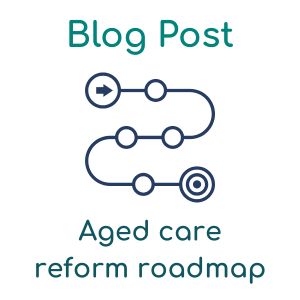
Aged care reform roadmap explained
First published: May 2024
The Department of Health and Aged Care have set a three-year roadmap to introduce aged care reforms to improve services delivered to the elderly population. These changes are being implemented with the aim to ensure all resources are of high quality, easily accessible and beneficial to the older people of Australia, now and in the future. The final report delivered by the Royal Commission into Aged Care Quality and Safety in March 2021 stated 148 recommendations that would reform the aged care sector. These recommendations keep care, dignity, and respect at the forefront of Australia’s aged care system, with the collective aim to put older people first.
It’s not just the ageing population of Australia that will be affected by the reforms. Aged care providers will see proposals that will help their business thrive in a competitive market, as well as helping to build a reputation of transparency and accountability. Aged care workers will be more recognised for the work that they do, being rewarded and supported wholly and fairly. All manner of aged care personnel is involved, endeavouring to strengthen communication between unions, consumer advocacy groups, industry experts, and partner government agencies, and frontline aged care workers.
Aged care reforms already in progress
The aged care roadmap to reform commenced in October 2022, and at present runs until July 2025. There have been several significant changes that have already been implemented and are underway:
Implementation date |
Aged Care Reform |
What this entails |
Aims and objectives |
| July 2022 | Quarterly Financial Report introduction | At specific dates throughout the year, in quarterly increments, providers of services to the elderly must submit a report to the Department of Health and Aged Care. What is included in the report depends on the service that you provide. Residential aged care providers will complete: questions on compliance, financial statements, labour costs, aged care worker hours reporting and food and nutrition reports. | The reason behind this is to improve transparency on finances and strengthening compliance. The reports provide information into financial oversight and AN-ACC (Australian National Aged Care Classification) funding, consumer choice, policy development, financial viability and helps regulate Quality Standards. |
| October 2022 | New aged care funding model | AN-ACC is the new funding model introduced that responds a recommendation in the Royal Commission report. | The funding aged care providers receive will be more in line with the requirements of the residents in their care. The costs required to deliver the level of care that the Australian aged care system should be delivering will be better met by the new funding model. |
| June 2023 | Elder Care Support Program | Focusing on the First Nation community, this new program provides services supporting families, carers and elders to access aged care services in urban, remote and regional areas of Australia. This program is being rolled out in phases until 2026. | Services to the elderly population need to be of high quality and easily accessible to all, in every part of Australia. |
| July 2023 | Aged Care Volunteer Visitor Scheme (ACVVS) | This free service, renamed the Aged Care Volunteer Visitor Scheme, focuses on supporting volunteers going into residential aged care homes to provide companionship and friendship to older people. | Focusing on the needs of the elderly population, it aims to reduce the level of social isolation older people face. There is a specific aim to attract volunteers to interact with residents that are from a range of linguistic, cultural and vulnerability backgrounds. |
| July 2023 | Aged care pay rise | Direct care workers received a 15% pay rise, which was on top of the 5.75% interim pay rise. Workers paid under three awards: Aged Care Award 2010, Nurses Award 2010 and the Social, Community, Home Care and Disability Services Industry Award 2010 were eligible. | Aiming to attract and retain the aged care workforce, this pay rise was implemented to recognise the work that care workers do for the elderly population. |
| October 2023 | 24/7 registered nurse responsibility and introduction of care minutes | From October 2023, residential aged care homes are legally required to report every month on the number of minutes each resident receives with a registered nurse and assistant in nursing. Each resident must receive 200 minutes a day with an assistant in nursing, 40 of those directly from a registered nurse. Along with this, there must be a registered nurse on site 24/7. Any periods where this didn’t happen needs to be reported each month. | This keeps homes accountable, to ensure each resident in a residential aged care home receives a high quality amount of care. |
Planned aged care reforms for 2024 – 2025
Reforms continue into 2025, and will include:
Implementation date |
Aged Care Reform |
What this entails |
Aims and objectives |
| March 2024 | Aged Care Taskforce Report final version | Examining the recommendations by the Aged Care Taskforce, there are 23 proposals split into four major objectives: supporting older people to age in place, fairer and sustainable funding, workforce attraction and retention, and providing quality and innovative services. | Formulated by 16 industry experts and board members, reports like these strive to reinforce continuous improvements and developments to the sector. |
| October 2024 | Continuation of care minutes | The implemented 200 minutes of care that a resident receives each day will increase to 215. 44 of these will be from a registered nurse. | Giving a boost to care levels increases the quality of services delivered to residents. |
| July 2025 | Expansion of the National Aged care Quality Indicator Program | The National Aged Care Quality Indicator (QI) Program includes 11 quality indicators across critical areas of care that affect the health and wellbeing of residents. Six additional indicators were added in April 2023, and this is due to expand further by July 2025. | Keeping residents safe and well through constant development of services adheres to the recommendations in the aged care reform report. |
| TBA | Development of the new Aged Care Act | The new aged care act, replacing the current from 1997 and 2018, aims to further improve services delivered to older people. It focuses on their life they lead at home, in community settings, and in residential aged care homes. Legislation is needed to implement more than 50 of the 148 recommendations from the Royal Commission. | Renewing laws is key in any area of legislation to keep laws up-to-date, safe and beneficial to all. |
| TBA | Continuation of the aged care pay rise | The Fair Work Commission issued their decision in Stage three of the Aged Care Value Work Case to increase the pay rise to 28%. Support service workers are expected to receive a 6.8% pay rise, with direct care workers receiving between 18 – 28%. | Reaffirming the importance and value of aged care workers, the pay rise ensures those working to service the elderly population of Australia matches others in the healthcare industry. |
These are the key dates of reform in the aged care industry, with various webinars and events included in between to get public opinion and contribution, to ensure it is beneficial for all. The full activities planned in the aged care reform report are subject to change and will be updated regularly.
What the reforms mean for the aged care industry
A complete revamp of the aged care industry processes means that everyone involved, from providers to workers and residents will benefit from high quality services that are relevant to everyone involved.
If you are already in the aged care sector, or if you are considering entering aged care at any level, its an exciting time that is filled with opportunity and prosperity. To contact our team to find out more about what becoming an aged care worker entails, or to develop your aged care career further, get in touch with our expert consultants today.


